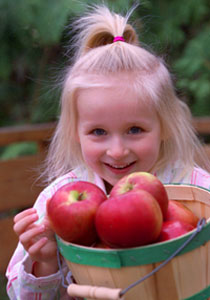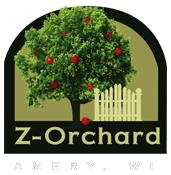Apples
A Note About our Z-Orchard Practices
 When researching practices used in orchards for pest control, I visited with a lot of people. I wanted to find the best practices with minimum amount of spraying of chemicals that I could find. Over the past 15 years we have tried many things and have found any organic practices we try are usually very labor intensive. One example is Thinning the fruit. We clip excess by hand; many orchards use chemicals to abort a portion of the flowers to thin the fruit. Ideally the apples should be thinned to the point that when they become full sized, the apples do not touch one another. When properly thinned you do not loose production (bushels) as the fruit is larger and trees put all of the energy into less fruit. An example is: If we spray to thin the apples it would take a couple of hours. Thinning 250 trees by hand easily takes a couple of weeks with much of the work done from ladders.
When researching practices used in orchards for pest control, I visited with a lot of people. I wanted to find the best practices with minimum amount of spraying of chemicals that I could find. Over the past 15 years we have tried many things and have found any organic practices we try are usually very labor intensive. One example is Thinning the fruit. We clip excess by hand; many orchards use chemicals to abort a portion of the flowers to thin the fruit. Ideally the apples should be thinned to the point that when they become full sized, the apples do not touch one another. When properly thinned you do not loose production (bushels) as the fruit is larger and trees put all of the energy into less fruit. An example is: If we spray to thin the apples it would take a couple of hours. Thinning 250 trees by hand easily takes a couple of weeks with much of the work done from ladders.
One of the people who I had discussions with was the late George Motz of Balsam Lake, WI. He told me that he had an orchard for 40 years, never sprayed and never had a real worm problem. He said he always kept geese in the orchard. The concept is that the geese will keep the ground free from apples that drop and also catch a lot of insects. The idea sounded good to me. I had geese in the orchard for several years, but now the USDA rules do not allow livestock in the Orchard.
I now use traps and lures to catch and detour the insects. Now I am using red Solo Cups covered with “Tanglefoot”. This product is sticky like long lasting fly paper and the red cups attract the female apple maggot flies and is very effective. We also use a special cardboard wrapped tightly around the trunk of the trees to catch Codling Moth larva. It is effective and very labor intensive as you need to change the cardboards monthly. We also have tried several other procedures with some success. ANYTHING you try organically is usually labor intensive. I experiment with an organic citric spray with limited success. Overall, these pest control practices do a good job on a small orchard like mine.
There is a natural lime spray used on the trees before they blossom. The lime is a natural product designed to smother any insect eggs hiding on the bark of the trees.
― Bill Z.
Owner, Z-Orchard

Did You Know?
“It takes about 36 apples to create one gallon of apple cider.”
“More than 2,500 varieties of apples are grown in the United States, but only the crabapple is native to North America.”
“Apples ripen six to 10 times faster at room temperature than if they are refrigerated.”
“Apples are a member of the rose family.”
“Apple trees take four to five years to produce their first fruit.”
“It takes the energy from 50 leaves to produce one apple.”
Our Apple Varieties
Beacon
This bright red apple is truly a “Beacon” in the landscape. It boasts a soft, juicy flesh and a slightly tart flavor. It creates a lovely pink skinless applesauce due to the red staining in the flesh. A favorite of many. Introduced in 1936.
Ripens mid- to late August
HoneyCrisp

Large, dappled red fruit with a well-balanced flavor, outstanding crispness and juiciness. Best for fresh eating and salads as the flesh is slow to brown. Fruit will easily store 7 or more months. Introduced in 1991.
Ripens late September
Haralson

Firm texture with a complex tart flavor. Good for fresh eating and cooking. Especially good pie apple. The fruit will store for 4 to 5 months. Tends to be biennial bearing. Introduced in 1922.
Ripens late September to early October
SnowSweet®

Savory, sweet tasting apple, with a slight tart balance and rich overtones. Amazingly slow to turn brown when cut. Appealing, large, bronze-red blush fruit. Excellent for fresh eating, snack trays, and salads. Introduced in 2006.
Ripens mid-October
Fireside/Connell

Very large fruit with sweet flavor and fine-grained flesh good for fresh eating, salad, and baked apples. Tree is vigorous and weeping. Introduced in 1943.
Ripens mid-October
Prairie Spy

Large, firm, dense fruit that is excellent for baking and long-term storage. Tree is very vigorous and productive. Introduced in 1940.
Ripens late October
Wolf River

Wolf River got its name naturally from the place it was found— on the banks of the Wolf River near Fremont, Wisconsin in 1875. Very large apple. Although considered by many to be a bit dry when eating fresh it is a prized dessert and baking apple
Ripens mid-September
